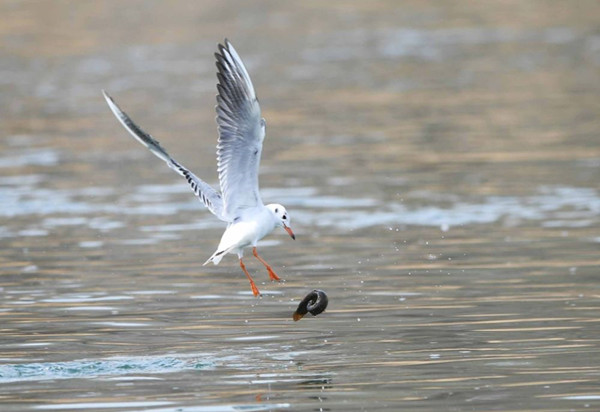
A water bird forages in Fenhe River Wetland Park in Taiyuan city. [Photo/Xinhua]
From chaotic and dirty coal-rich urban sprawl to modern livable city, Taiyuan, capital of North China's Shanxi province, has had a total revamp over the past few years and now offers a benchmark for just how resource-based metropolises can transform themselves by taking care of their mountains, water, air and environment and managing their urban development.
Mountain treatment
Before overmining and heavy pollution from heavy industry in modern times, West Mountain and East Mountain in Taiyuan was rich in vegetation. Then, to achieve an ecological reboot for the two mountains, Taiyuan acted and encouraged private companies and capital to carry out large-scale afforestation over the past few years.
Now, according to local government policy, a company can only use up to 20 percent of its contracted land to build production and support buildings and facilities -- requiring it to afforest the remaining 80 percent of the land.
Local officials said that the city's environmentally friendly policies sparked a new wave of urban development by local State-owned and private enterprises.
According to the director of the Management Committee of Taiyuan West Mountain Ecological and Cultural Tourism Demonstration Zone, 16 suburban forest parks -- with a total investment of over 10 billion yuan ($1.41 billion) -- have been built in areas surrounding West Mountain in just a few years, transforming barren mountains into a lush, verdant place.
As a result, the two mountains have become ideal destinations and green landmarks for locals and tourists.
Quite a few participants in the 2019 Tour of Taiyuan, an international road cycling race held last May, were reportedly delighted with the scenery along the competition track around West Mountain.
Water treatment
At one point, the long-term overuse and water pollution of the Fenhe River that runs through Taiyuan, as well as the pollution in nine tributaries from West Mountain and East Mountain, troubled locals living along the waterways.
To restore the Fenhe River, Taiyuan has been treating the urban sections of the main stretch of the river for decades.
"From the first phase of the treatment project in 1998 to the completion of the third phase of the project in 2019, Taiyuan has built a 33-kilometer Fenhe River landscape belt through 21 years of effort," said Hou Gang, director of the local Fenhe Scenic Spot Management Committee.
The restoration and management of the nine tributaries has also been implemented in recent years -- with upstream soil and water conservation, river management, rainwater and sewage diversion, road reconstruction, greening and underground utility tunnel construction still underway.
As a result, more locals are now to be seen walking and exercising along the nine tributaries, which were turned into landscape and recreational belts after their makeover.
